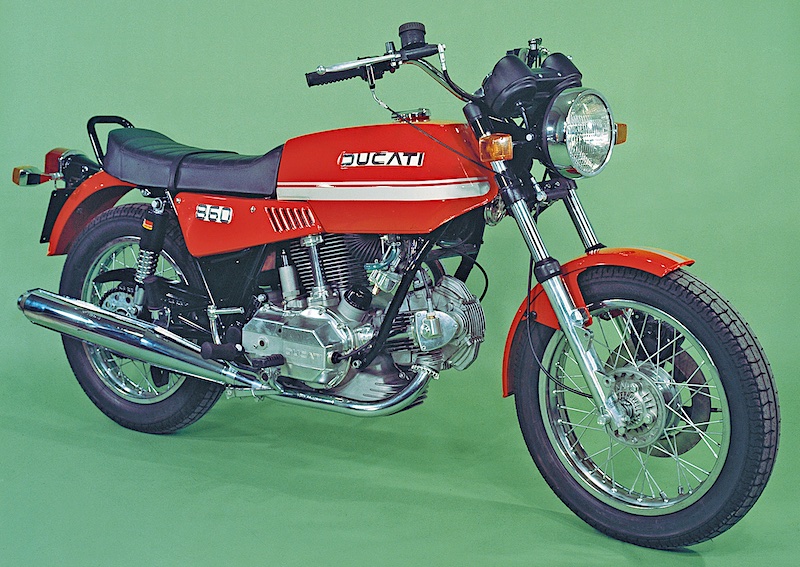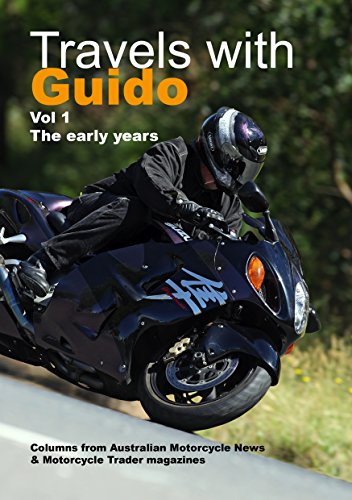Motorcycle Investor mag
Subscribe to our free email news
Ducati 860 GT
(by Ian Falloon, Feb 2022)

Sharp suit
for a new era
The release
of the Ducati 860 GT in 1974 was the harbinger of a
change in direction for Ducati. Prior to the 860,
Ducati’s design had been a result of gradual evolution,
but for the 860 Ducati engaged the services of an
outside stylist, Giorgetto
Giugiaro.
But there was
more to the 860 than a cosmetic restyle of the earlier
750 GT. More stringent noise regulations would mean the
days of barking Conti exhausts were numbered, and the US
Department of Transport required all motorcycles built
after September 1974 to shift on the left. Besides being
quieter and more environmentally friendly, Ducati also
wanted the 860 GT to be cheaper to manufacture than the
complex round-case 750.
To the casual
observer the 860 GT looked to be a superficial styling
exercise based on the 750 but there was much more to the
860 than merely an overbore. The entire machine was
redesigned and restyled with the intention of making it
more appealing to the US market.
The engine
also underwent considerable modification, firstly to
simplify manufacture, and secondly to improve
reliability and minimise maintenance. There were a large
number of engine updates for the 860 engine compared to
the round-case 750, notably to the bevel-gear camshaft
drive and lubrication system, and to maintain the
already modest performance of the 750 GT the engine was
enlarged to 864cc.
The most
noticeable feature of the 860 engine was the redesigned
outer engine covers. This included the alternator,
clutch, bevel, and gearshift covers. Underneath the
reshaped alternator cover was a new bevel-gear drive to
the two vertical shafts and instead of the 750’s
ignition points housing between the cylinders was an oil
filter.
Most of the
other engine internals were unchanged, but the 860 now
featured electronic ignition. With a pair of Dell’Orto
PHF 32mm carburettors and angular Lafranconi mufflers
the 860 GT’s power was modest (no claims were made but
it was around 65 horsepower) but mid-range torque was
improved over the 750.
Most 860s
also had an electric start, making the bike easier to
live with.
The 860 GT
also had a new frame, with eccentric chain adjusters at
the swingarm pivot, and 18-inch wheels front and rear.
The front fork was a stout 38mm Ceriani, with either a
single or twin Brembo front disc brake, with Marzocchi
rear shock absorbers.
Ducati went
to some effort to improve many components that had come
under criticism on the 750 and to meet new US standards.
Only US-style high and wide handlebar was fitted to the
860 GT, with the wires through the bars, and the
switches were a new blocky CEV. These CEV switches may
have promised much but they were still ergonomically
compromised.
The 860 GT
was released in a blaze of publicity, with rave reviews
from the press. But the press claims of “The Best Duke
Yet” were not translated into sales.
Although the
860 did most things well enough, it wasn’t any better
than the earlier 750 GT.
Although
history has been unkind to the 860 GT, some of its
misfortune was due to unfortunate timing. The 860 GT’s
release coincided with a worldwide motorcycle sales
slump and the more European inspired 860 GTS soon
replaced it.
Finally the
860 GT’s time has possibly come. As modern motorcycles
adopt a hard-edged style the 860 GT has begun to look
more contemporary, something few nearly 50-year-old
motorcycles can emulate.
More on stylist Giugiaro here at Unique Cars magazine
-------------------------------------------------
Produced by AllMoto abn 61 400 694 722
Privacy: we do not collect cookies or any other data.

Archives
Contact





